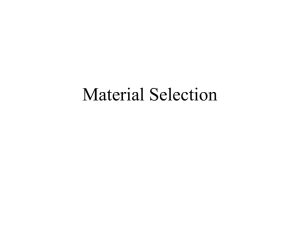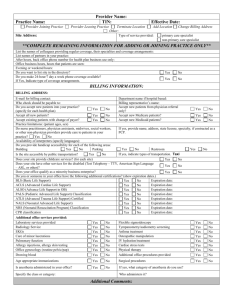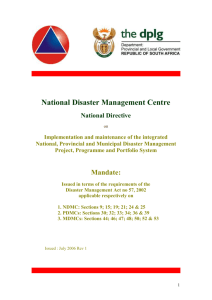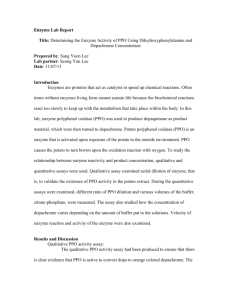Extended Linear Cryptanalysis and Extended Piling
advertisement
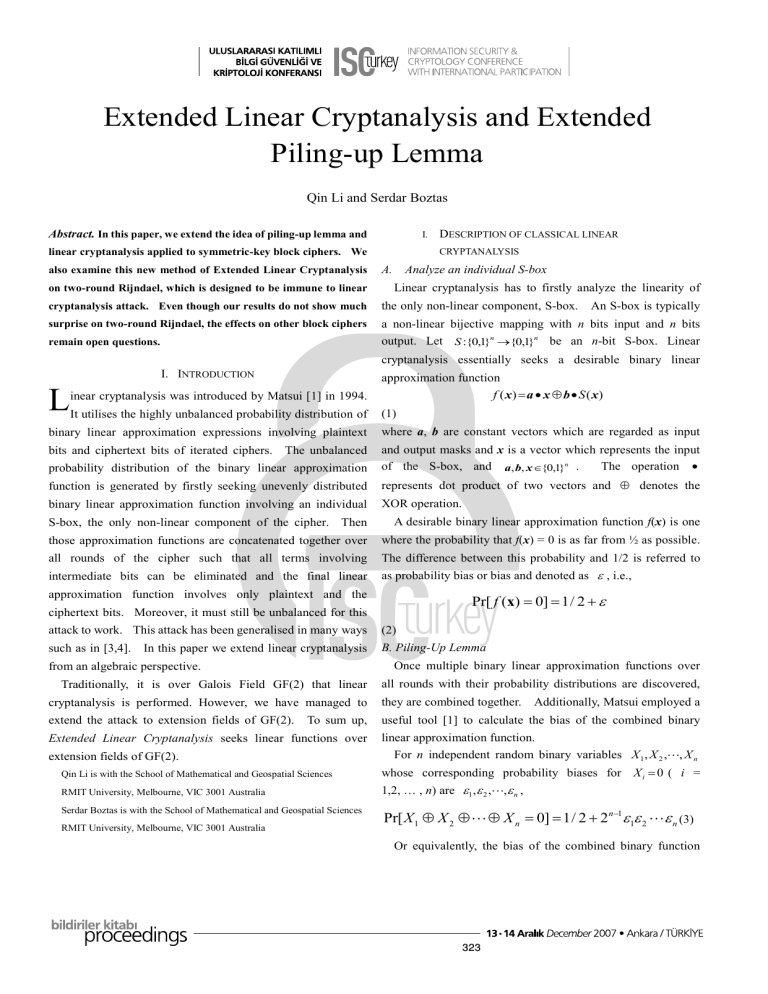
Extended Linear Cryptanalysis and Extended
Piling-up Lemma
Qin Li and Serdar Boztas
Abstract. In this paper, we extend the idea of piling-up lemma and
I.
linear cryptanalysis applied to symmetric-key block ciphers. We
also examine this new method of Extended Linear Cryptanalysis
on two-round Rijndael, which is designed to be immune to linear
DESCRIPTION OF CLASSICAL LINEAR
CRYPTANALYSIS
A.
Analyze an individual S-box
Linear cryptanalysis has to firstly analyze the linearity of
cryptanalysis attack. Even though our results do not show much
the only non-linear component, S-box.
surprise on two-round Rijndael, the effects on other block ciphers
a non-linear bijective mapping with n bits input and n bits
output. Let S :{0,1}n o{0,1}n be an n-bit S-box. Linear
remain open questions.
An S-box is typically
cryptanalysis essentially seeks a desirable binary linear
I. INTRODUCTION
L
inear cryptanalysis was introduced by Matsui [1] in 1994.
approximation function
f ( x) a x x b x S ( x)
It utilises the highly unbalanced probability distribution of
(1)
binary linear approximation expressions involving plaintext
where a, b are constant vectors which are regarded as input
bits and ciphertext bits of iterated ciphers.
probability distribution of the binary linear approximation
and output masks and x is a vector which represents the input
of the S-box, and a, b, x {0,1}n .
The operation x
function is generated by firstly seeking unevenly distributed
represents dot product of two vectors and denotes the
binary linear approximation function involving an individual
XOR operation.
The unbalanced
S-box, the only non-linear component of the cipher. Then
A desirable binary linear approximation function f(x) is one
those approximation functions are concatenated together over
where the probability that f(x) = 0 is as far from ½ as possible.
all rounds of the cipher such that all terms involving
The difference between this probability and 1/2 is referred to
intermediate bits can be eliminated and the final linear
as probability bias or bias and denoted as H , i.e.,
approximation function involves only plaintext and the
Pr[ f (x)
ciphertext bits. Moreover, it must still be unbalanced for this
attack to work. This attack has been generalised in many ways
(2)
such as in [3,4]. In this paper we extend linear cryptanalysis
B. Piling-Up Lemma
0] 1 / 2 H
Once multiple binary linear approximation functions over
from an algebraic perspective.
Traditionally, it is over Galois Field GF(2) that linear
all rounds with their probability distributions are discovered,
cryptanalysis is performed. However, we have managed to
they are combined together.
extend the attack to extension fields of GF(2).
To sum up,
useful tool [1] to calculate the bias of the combined binary
Extended Linear Cryptanalysis seeks linear functions over
linear approximation function.
For n independent random binary variables X1 , X 2 ,, X n
extension fields of GF(2).
Additionally, Matsui employed a
Qin Li is with the School of Mathematical and Geospatial Sciences
whose corresponding probability biases for X i 0 ( i =
RMIT University, Melbourne, VIC 3001 Australia
1,2, … , n) are H1 ,H 2 ,,H n ,
Serdar Boztas is with the School of Mathematical and Geospatial Sciences
RMIT University, Melbourne, VIC 3001 Australia
Pr[ X 1 X 2 X n
0] 1 / 2 2n1H1H 2 H n (3)
Or equivalently, the bias of the combined binary function
323
X1 X 2 X n 0 equals 2n1H1H 2 H n .
relevant extension field.
C. Combine binary linear approximation function over whole
Definition 1 Let K be a finite field with q elements and F be
an extension field of K with qm elements. For a F , the trace
cipher and extract partial key bits
Now we are able to concatenate multiple binary linear
approximation functions over different rounds and to calculate
TrF/K(a) of a over K is defined by
the probability bias of the new binary linear approximation
TrF / K (a) a a q a q
function. When the combined binary linear function over
(5)
whole cipher is generated, it can be represented in the form
f1 ( x) f 2 ( x) f n ( x) a x x b x EK ( x)
m 1
Binary linear cryptanalysis
(4)
where a, b are constant vectors which are regarded as input
block cipher, and EK(x), in the form of vector, is the output of
a,b n bits
the second last round of the cipher encrypted using key K.
x
The operation x and represent dot product and XOR
respectively.
1 bit
a x x b x S (x)
and output masks and x is a vector represents the input of the
All other intermediate values are eliminated.
n bits
GF (2) n
or
By applying piling-up lemma, (4) has probability bias of
r 2n1 H1H 2 H n . This bias specifies the vulnerability of the
S(x)
n bits
GF (2) n
or
S-box
n
GF (2 )
x n bits
cipher. It can be exploited to find partial key bits of the cipher.
S(x)
GF (2 n )
n bits
a,b n bits
II. EXTENDED LINEAR CRYPTANALYSIS
Tr(a x b S ( x))
It can be seen from previous description of linear
GF (2)
d bits
GF (2 d )
cryptanalysis that binary linear cryptanalysis is performed over
vector spaces {0,1}n, where n is the number of the input/output
bits of the cipher being analyzed. See Fig. 1.
The input bits, x, and the output bits, S(x), are represented
as vectors, as well as the constant masks values a and b.
Extended Linear Cryptanalysis
Fig.1. Difference between binary and Extended Linear Cryptanalysis
The
binary linear approximation function is indeed a sum of a dot
product of a and x and another dot product of b and S(x).
On the contrary, Extended Linear Cryptanalysis is carried
n
The trace function has the following well-known properties
(see [5]) which we shall use in this paper:
TrF/K(a)
K
for
out over GF(2 ), where n denotes the number of the
(6)
input/output bits of the S-box.
TrF/K(a+b)=TrF/K(a)+TrF/K(b)
The linear approximation
function is computed in finite fields instead of in vector spaces
over GF(2).
all
for
a,
b
F
F
(7)
The input and the output of the S-box, as well as
the constant masks a and b, are represented as elements of the
n
finite field of GF(2 ).
The probability distribution, of course,
n
can be computed over any subfield of GF(2 ).
B.
Analyzing individual S-box of Rijndael
In this paper, we use Rijndael [2] to demonstrate Extended
Linear Cryptanalysis.
In Rijndael, there is only one S-box.
it has eight bits input and output.
A.
all
a
Trace function
Like the Rijndael
description [2], the input and output of the S-box are
In this paper, we apply the trace function over finite fields as
represented as elements of finite field GF(28) in this paper. The
the linear approximation function—note that by using a pair of
input bit string x7 x 6 x 5 x 4 x 3 x 2 x 1 x 0 represents the input byte
dual bases, this can be reduced to an inner product over the
x where x = x 7α7+ x 6α6+ x 5α5+ x 4α4+ x 3α3+ x 2α2+ x 1α+ x 0,
324
and the output bit string y7 y 6 y 5 y 4 y 3 y 2 y 1 y 0 represents the
7
6
5
4
3
output bytes y where y = y 7α + y 6α + y 5α + y 4α + y 3α + y
2
mask pairs with which the trace function (8) produces the most
unbalanced probability over GF(2).
The absolute value of the
-4
+ y1α+ y0. Both x and y are the elements of the finite field
highest bias is 16/256=2 . There are three (a,b) constant mask
GF(256) with the irreducible polynomial α8+α4+α3+α+1 as the
pairs with which the trace function (9) produces the most
reduction polynomial.
unbalanced probability over GF(4).
2α
Because finite field GF(256) has three proper subfields,
-4
highest bias is 24/256=1.5×2 .
The absolute value of the
There are 15 (a,b) constant
namely GF(2), GF(4) and GF(16), we will analyse the
mask pairs with which the trace function (10) produces the
probability distributions of trace functions over the three
most unbalanced probability over GF(16).
The absolute
-4
subfields:
TrGF ( 256) / GF ( 2) (a x b y)
value of the highest bias is 24/256≈1.1×2 .
(8)
TrGF ( 256) / GF ( 4) (a x b y)
Extended Linear Cryptanalysis is performed over GF(4) and
By comparing the three results it is found that when the
GF(16), the biases we obtain are higher than over GF(2).
(9)
TrGF ( 256) / GF (16) (a x b y)
C.
(10)
Extended Piling-up Lemma
After analyzing the probability biases of the trace function
where a, b are constant input and output mask values and x, y
in the form of Tr(ax+by) based on the input and the
are the input and its corresponding output of S-box of Rijndael, corresponding output of an individual S-box, we will show
respectively.
a, b, x and y are all elements of GF(256) and
(when multiple trace functions are added together) how the
the addition and multiplication operations are also under
probability distribution of a new trace function is obtained.
GF(256).
Here we introduce a new mathematical model–The Extended
For each of them, we are going to search for the best mask
Piling-Up Lemma–to compute the probability distribution of a
values (a, b) such that the probability distribution of each trace
combined trace function. The Extended Piling-Up Lemma is
function is the most unbalanced.
essentially a generalized piling-up Lemma [1].
The probability distribution of a trace function with a fixed
(a, b) pair can be computed by replacing x and y with the input
introduce
this
model
starting
with
the
We will
following
straightforward example:
and corresponding output value of S-box in the form of
Let U1, U2 be random variables whose sample space is
elements of GF(256) and then going through all 28=256
GF(4). Alternatively, the domain of random variables U1, U2
input/output values.
are {0, 1, z, z+1} where 0, 1, z and z+1 are all the entire
For each trace function among (8), (9)
and (10), there are 2
value pairs (a,b).
16
possible options for the constant mask
We need figure out the best (a,b) mask
pairs with which the trace function produces the highest
unbalanced probability distribution.
The results of this paper
were obtained by using Magma [6] as a software platform to
search for desirable (a, b) mask pairs.
When probability distribution of the trace function is over
elements of GF(4). Let
U1 ~ (Pr1(0), Pr1(1), Pr1(z), Pr1(z+1))
U2 ~ (Pr2(0), Pr2(1), Pr2(z), Pr2(z+1))
denote the probability distributions of the random variables U1
and U2 respectively, where Pri(X) is the probability that Ui=X.
Applying our knowledge of finite fields and probability
theory, we get the following result (essentially a convolution
extension field of GF(2), such as GF(4) and GF(16), however,
of probability distributions):
to determine the probability bias becomes more complex
Pr(U1 U 2 0) Pr1 (0) u Pr2 (0) Pr1 (1) u Pr2 (1) Pr1 ( z ) u Pr2 ( z ) Pr1 ( z 1) u Pr2 ( z 1)
(11)
Pr(U1 U 2 1) Pr1 (0) u Pr2 (1) Pr1 (1) u Pr2 (0) Pr1 ( z ) u Pr2 ( z 1) Pr1 ( z 1) u Pr2 ( z )
(12)
Pr(U1 U 2 z ) Pr1 (0) u Pr2 ( z ) Pr1 (1) u Pr2 ( z 1) Pr1 ( z ) u Pr2 (0) Pr1 ( z 1) u Pr2 (1)
(13)
because the domain of the trace function has more than two
values.
In this paper, we simply refer to the maximum
amount by which the probability of the trace function deviates
from the uniform probability as the probability bias.
Our experiments show that there are 1275 different (a,b)
325
Pr(U1 U 2 z 1) Pr1 (0) u Pr2 ( z 1) Pr1 (1) u Pr2 ( z ) Pr1 ( z ) u Pr2 (1) Pr1 ( z 1) u Pr2 (0)
(14)
The above computation can be represented as matrix
multiplication as follows. Let the 1×4 matrix
(Pr1+2(0),Pr1+2(1),Pr1+2(z),Pr1+2(z+1))
denote the probability distribution of U1+U2, then
Pr12 (0) Pr12 (1) Pr12 ( z ) Pr12 ( z 1)
Pr1 (1)
Pr1 ( z ) Pr1 ( z 1) · § Pr2 (0) ·
§ Pr1 (0)
¨ Pr (1)
Pr
(
0
)
Pr
Pr1 ( z ) ¸¸ ¨¨ Pr2 (1) ¸¸
1
1
1 ( z 1)
¨
u
Pr1 (1) ¸ ¨ Pr2 ( z ) ¸
¨ Pr1 ( z ) Pr1 ( z 1) Pr1 (0)
¸
¨ Pr ( z 1) Pr ( z )
Pr1 (1)
Pr1 (0) ¹ ¨© Pr2 ( z 1) ¸¹
1
© 1
(15)
be the probability distribution of the sum of the random
variables U1+U2+…+Un, then
Pr1 2... n (0) Pr1 2... n (1) Pr1 2... n ( z ) Pr1 2... n ( z 1)
Pr1 (1)
Pr1 ( z ) Pr1 ( z 1) ·
§ Pr1 (0)
¨ Pr (1)
Pr
(
0
)
Pr
Pr1 ( z ) ¸¸
1
1 ( z 1)
¨ 1
u
(16)
Pr1 (1) ¸
¨ Pr1 ( z ) Pr1 ( z 1) Pr1 (0)
¨ Pr ( z 1) Pr ( z )
¸
Pr1 (1)
Pr1 (0) ¹
1
© 1
Pr2 (1)
Pr2 ( z ) Pr2 ( z 1) ·
§ Prn (0) ·
§ Pr2 (0)
¸
¨
¨ Pr (1)
¸
Pr
(
0
)
Pr
(
z
1
)
Pr
(
z
)
2
2
2
2
¨
¸ uu ¨ Prn (1) ¸
Pr2 (1) ¸
¨ Prn ( z ) ¸
¨ Pr2 ( z ) Pr2 ( z 1) Pr2 (0)
¨ Pr ( z 1) Pr ( z )
¨ Pr ( z 1) ¸
Pr2 (1)
Pr2 (0) ¸¹
2
© 2
¹
© n
When the sample space of the random variables is GF(16),
Pr1 (1)
Pr1 ( z ) Pr1 ( z 1) ·
§ Pr1 (0)
¨ Pr (1)
Pr
(
0
)
Pr
Pr1 ( z ) ¸¸
1
1
1 ( z 1)
where ¨
is a square
Pr1 (1) ¸
¨ Pr1 ( z ) Pr1 ( z 1) Pr1 (0)
¨ Pr ( z 1) Pr ( z )
¸
Pr1 (1)
Pr1 (0) ¹
1
© 1
the probability distribution of the sum of the variables Ui
where i {0,1,, n} is
matrix
generated
from
the
row
vector
Pr1 (0) Pr1 (1) Pr1 ( z) Pr1 ( z 1) by using the Cayley table of
§
Pr1 (0)
Pr1 (1)
¨
Pr
(
1
)
Pr
¨
1
1 (0)
¨
¨ Pr (z 3 z 2 z 1) Pr (z 3 z 2 z)
1
© 1
§
Pr2 (0)
Pr2 (1)
¨
Pr2 (1)
Pr2 (0)
¨
¨
¨ Pr (z 3 z 2 z 1) Pr (z 3 z 2 z)
2
© 2
Prn (0)
§
·
¨
¸
Prn (1)
¨
¸
u
¨¨
¸¸
3
2
© Prn (z z z 1) ¹
the additive group of GF(4).
The general scheme to create such 2n×2n matrix from a 2n
elements row vector can also be described recursively as:
1.
Pair up two consecutive elements of the row vector from
one side to another;
2.
Generate square matrices for every pair by using the
following rule (Cayley table of (GF(2),+)):
(17)
probability distribution of the sum of any finite number of
step in order that the first row of the matrix concatenated
random variables Ui whose sample space is a finite field F,
where i {0,1, , n} ,. However, we do not pursue this further
is identical as the initial row vector;
here.
Concatenate the new generated square matrices from last
4.
Pr1 (z 3 z 2 z 1) ·
¸
Pr1 (z 3 z 2 z) ¸ u
¸
¸
Pr1 (0)
¹
3
2
Pr2 (z z z 1) ·
¸
Pr2 (z 3 z 2 z) ¸ u
¸
¸
Pr2 (0)
¹
Using the same systematic method, we can compute the
a b §¨ a b ·¸ ;
©b a¹
3.
(Pr12n (1), Pr12n (2),, Pr12n (z 3 z 2 z 1))
Treat the new concatenated matrix as a row vector whose
5.
elements are the square matrices from the last step;
D.
Repeat step 1 to 4 until the new concatenated matrix itself
two-round Rijndael variant
is a square matrix.
Combine linear approximation trace functions over
Similar to binary linear cryptanalysis, Extended Linear
In the following section of this paper, all square matrices
generated from row vectors are created by using this scheme.
Now, we can extend this example to compute the probability
Cryptanalysis is also very sensitive to the structure of the
block cipher. Here we use a two-round Rijndael variant as an
example to show how to concatenate multiple approximation
distribution of the sum of finitely many random variables:
trace functions over the whole cipher. The structure of
Let
two-round Rijndael variant is shown in the two-dimensional
Ui~(Pri(0), Pri(1), Pri(z), Pri(z+1)) be the probability
distributions of the random variables Ui whose sample space is
GF(4), where i {0,1,, n} .
graphical demonstration of Fig. 2, where
Let the 1×4 matrix
Equivalently, it is a bitwise XOR operation applied on two
(Pr1+2+…+n(0), Pr1+2+…+n(1), Pr1+2+…+n(z), Pr1+2+…+n(z+1))
8-bit inputs, generating one 8-bit output.
326
represents AddRoundKey operation applied on one byte.
S represents SubBytes operation applied on one byte.
Equivalently, it is an S-box with 8-bit input and output.
K 0,1,1 P1,1
0 E Z1,1,1 0 B Z1, 2,1 0 D Z1,3,1 09 Z1, 4,1
X 2,1,1 K1,1,1 ,
Z1, 2,1 X 2, 2,1 K1, 2,1
X 2,3,1 K1,3,1 ,
Z1, 4,1 X 2, 4,1 K1, 4,1
0 E Z 2,1,1 0 B Z 2, 2,1 0 D Z 2,3,1 09 Z 2, 4,1
C1,1 K 2,1,1 ,
Z 2, 2,1 C2,1 K 2, 2,1
C3,1 K 2,3,1 ,
Z 2, 4,1 C4,1 K 2, 4,1
09 Z 2,1, 4 0 E Z 2, 2, 4 0 B Z 2,3, 4 0 D Z 2, 4, 4
C1, 4 K 2,1, 4 ,
Z 2, 2, 4 C2, 4 K 2, 2, 4
C3, 4 K 2 , 3, 4 ,
Z 2, 4, 4 C4, 4 K 2, 4, 4
0 D Z 2,1,3 09 Z 2, 2,3 0 E Z 2,3,3 0 B Z 2, 4,3
C1,3 K 2,1,3 ,
Z 2, 2,3 C2,3 K 2, 2,3
C3, 3 K 2 , 3, 3 ,
Z 2, 4,3 C4,3 K 2, 4,3
0 D Z 2,1, 2 09 Z 2, 2, 2 0 E Z 2,3, 2 0 B Z 2, 4, 2
C1, 2 K 2,1, 2 ,
Z 2, 2, 2 C2, 2 K 2, 2, 2
C 3, 2 K 2 , 3, 2 ,
Z 2, 4, 2 C4, 2 K 2, 4, 2
the k-th column of the state in the i-th round. Note that K0,j,k
X 1,1,1
Y1,1,1
Z1,1,1
Z1,3,1
Y2,1,1
Z 2,1,1
Z 2,3,1
Y2, 2,1
Z 2,1, 4
Z 2 , 3, 4
Y2,3,1
Z 2,1,3
Z 2 , 3, 3
Y2, 4,1
Z 2,1, 2
Z 2 , 3, 2
represents the initial key byte preceding the two-round. Xi,j,k
where 0E, 0B, 0D, 09 are hexadecimal representations of the
and Yi,j,k correspondingly denotes an input and an output byte
constant elements in GF(256). They are respectively:
M
represents MixColumns operation applied on
four bytes. It is sometimes called a D-box with 32-bit input
and output.
represents flow of one byte (8 bits) of plaintext,
ciphertext, sub-key or intermediate state. Moreover, ShiftRows
is also implemented by crossover of lines with arrows.
Pj,k, Cj,k correspondingly denote one plaintext or ciphertext
byte (8 bits) at the j-th row and the k-th column of the state.
Ki,j,k represents one round-key byte (8 bits) at the j-th row and
of an S-box where subscript i, j and k represents the byte is at
the j-th row and the k-th column of the state in the i-th round.
Similarly, Yi,j,k and Zi,j,k correspondingly denotes an input and
an output byte of a D-box where subscript i, j and k represents
0E
0B
0D
09
(19)
D 3 D 2 D
D 3 D 1
D 3 D 2 1
D 3 1
(20)
b1,1,1 0 E
b1,1,1 0 B
b1,1,1 0 D
b1,1,1 09
(21)
the byte is at the j-th row and the k-th column of the state in
the i-th round.
It is clear from Fig. 2 that we combine approximation trace
functions based on the inputs and outputs of S-boxes S1,1,1,
S2,1,1, S2,2,1, S2,3,1 and S2,4,1 to create a new trace function. The
new combined trace function will involve only the first byte of
the plaintext and all bytes of the ciphertext.
For each one of the involving S-boxes, we can get a best
linear approximation trace function over each of GF(2), GF(4)
and GF(16). Then we can concatenate these five trace
functions as following:
If
a2,1,1
a2, 2,1
a2,3,1
a2, 4,1
then the combined trace function (21) equals
Tr1,1,1 2,1,1 2, 2,1 2,3,1 2, 4,1 (a1,1,1 P1,1
b2,1,1 0 E C1,1 b2,1,1 0 B C 2,1 b2,1,1 0 D C3,1 b2,1,1 09 C 4,1
b2, 2,1 09 C1, 4 b2, 2,1 0 E C 2, 4 b2, 2,1 0 B C3, 4 b2, 2,1 0 D C 4, 4
b2,3,1 0 D C1,3 b2,3,1 09 C 2,3 b2,3,1 0 E C3,3 b2,3,1 0 B C 4,3
b2, 4,1 0 B C1, 2 b2, 4,1 0 D C 2, 2 b2, 4,1 09 C3, 2 b2, 4,1 0 E C 4, 2 (22)
b2,1,1 0 E K 2,1,1 b2,1,1 0 B K 2, 2,1 b2,1,1 0 D K 2,3,1 b2,1,1 09 K 2, 4,1
b2, 2,1 09 K 2,1, 4 b2, 2,1 0 E K 2, 2, 4 b2, 2,1 0 B K 2,3, 4 b2, 2,1 0 D K 2, 4, 4
b2,3,1 0 D K 2,1,3 b2,3,1 09 K 2, 2,3 b2,3,1 0 E K 2,3,3 b2,3,1 0 B K 2, 4,3
b2, 4,1 0 B K 2,1, 2 b2, 4,1 0 D K 2, 2, 2 b2, 4,1 09 K 2,3, 2 b2, 4,1 0 E K 2, 4, 2 )
Tr1,1,1 (a1,1,1 X 1,1,1 b1,1,1Y1,1,1 ) Tr2,1,1 (a2,1,1 X 2,1,1 b2,1,1Y2,1,1 ) Tr2, 2,1 (a2, 2,1 X 2, 2,1 b2, 2,1Y2, 2,1 ) Tr2,3,1 (a2,3,1 X 2,3,1 b2,3,1Y2,3,1 ) Tr2, 4,1 (a2, 4,1 X 2, 4,1 b2, 4,1Y2, 4,1 )
(18)
Tr1,1,12,1,1 2, 2,12,3,12, 4,1 (a1,1,1 X 1,1,1 b1,1,1Y1,1,1 a2,1,1 X 2,1,1 b2,1,1Y2,1,1 a2, 2,1 X 2, 2,1 b2, 2,1Y2, 2,1 It is worth noting that the combined trace function (22)
a2,3,1 X 2,3,1 b2,3,1Y2,3,1 a2, 4,1 X 2, 4,1 b2, 4,1Y2, 4,1 )
involves only the first byte of the plaintext and all bytes of the
From the description of Rijndael [2] and Fig. 2, we know:
ciphertext of two-core-round Rijndael. All other terms that are
left are merely constants, given the initial key of the cipher is
fixed.
Now we can make use of previous results of probability
distribution of individual S-box and Extended Piling-up
Lemma to compute the probability bias, over GF(2), GF(4)
and
GF(16),
of (22),
which is
an
extended
linear
approximation function for the two-round Rijndael variant.
327
The results show that the possible highest biases of the
In this paper, we have introduced Extended Linear
combined trace function (22) over GF(2), GF(4) and GF(16)
Cryptanalysis, as well as Extended Piling-up Lemma. It is of
-16
are 2 , 1.5×2
-16
and 2
-17.22
correspondingly. Obviously, unlike
binary linear cryptanalysis, we have more choices to
interest to apply this idea on other block ciphers, or to improve
the result on Rijndael.
approximate a cipher using Extended Linear Cryptanalysis.
CONCLUSIONS AND POSSIBLE FUTURE DIRECTIONS
K0,1,1
P4,4
P4,3
P3,4
P4,1
P4,2
P3,3
P2,4
P3,1
P3,2
P2,3
P2,1
P2,2
P1,4
P1,2
P1,3
P1,1
K0,4,4
K0,4,3
K0,3,4
K0,4,2
K0,4,1
K0,3,3
K0,2,4
K0,3,2
K0,3,1
K0,2,3
K0,2,1
K0,2,2
K0,1,4
K0,1,2
K0,1,3
X1,4,4
X1,4,3
X1,3,4
X1,4,1
X1,4,2
X1,3,3
X1,2,4
X1,3,1
X1,3,2
X1,2,3
X1,2,1
X1,2,2
X1,1,4
X1,1,1
X1,1,2
X1,1,3
S1,1,1
Y1,1,1
S
Y1,1,2
S
Y1,1,3
S
Y1,1,4
S
Y1,2,1
S
Y1,2,4
S
Y1,3,1
S
Y1,3,2
S
Y1,3,3
S
Y1,3,4
S
Y1,4,1
S
Y1,4,2
S
Y1,4,3
S
Y1,4,4
M
M
Z1,4,4
Z1,4,3
Z1,3,4
Z1,4,1
Z1,4,2
Z1,3,3
Z1,2,4
Z1,3,1
Z1,3,2
Z1,2,3
Z1,2,1
Z1,2,2
Z1,1,4
Z1,1,1
Z1,1,2
Z1,1,3
K1,4,4
K1,4,3
K1,3,4
K1,4,2
K1,4,1
K1,3,3
K1,2,4
K1,3,2
K1,3,1
K1,2,3
K1,2,1
K1,2,2
K1,1,4
K1,1,2
K1,1,3
X2,4,4
X2,4,3
X2,3,4
X2,4,1
X2,4,2
X2,3,3
X2,2,4
X2,3,1
X2,3,2
X2,2,3
X2,2,1
X2,2,2
X2,1,4
X2,1,1
X2,1,2
X2,1,3
S2,1,1
Y2,1,1
S
Y2,1,2
S
Y2,1,3
S
S2,2,1
Y2,2,1
Y2,1,4
M
K2,1,1
S
Y1,2,3
M
M
K1,1,1
S
Y1,2,2
S
Y2,2,2
S
Y2,2,3
S
S2,3,1
Y2,2,4
Y2,3,1
M
S
Y2,3,2
S
Y2,3,3
S
S2,4,1
Y2,3,4
Y2,4,1
M
S
Y2,4,2
S
Y2,4,3
S
Y2,4,4
M
Z2,4,4
Z2,4,3
Z2,3,4
Z2,4,1
Z2,4,2
Z2,3,3
Z2,2,4
Z2,3,1
Z2,3,2
Z2,2,3
Z2,2,1
Z2,2,2
Z2,1,4
Z2,1,1
Z2,1,2
Z2,1,3
K
K
K
K
K
2,4,4
K
K2,2,4
2,4,3
K2,3,2
K2,3,1
2,3,4
K2,2,3
2,4,1
2,4,2
2,3,3
K2,2,1
K2,2,2
K2,1,4
K2,1,2
K2,1,3
C4,4
C4,3
C3,4
C4,1
C4,2
C3,3
C2,4
C3,1
C3,2
C2,3
C2,1
C2,2
C1,4
C1,1
C1,2
C1,3
Fig. 2 Two dimensional graphical demonstration of two-round Rijndael variant
Besides, how best to measure the probability bias of a
random variable whose sample space has more than two
elements is an interesting problem. Some recent work in [7] has
investigated this question in general.
328
REFERENCES
[1]
M. Matsui, “Linear Cryptanalysis Method
for
DES Cipher,”
EUROCRYPT ’93, LNCS, Vol. 765, Springer-Verlag, pp.386-397, 1994
[2]
Joan Daemen and Vincent Rijmen. The design of Rijndael: AES – The
Advanced Encryption Standard. Springer, 2002
[3]
C. Harpes, G. Kramer and J. Massey, “A Generalization of Linear
Cryptanalysis and the Applicability of Matsui’s Piling-up Lemma”
EUROCRYPT ’95, LNCS, vol.921, Springer-Verlag, pp.24-38, 1995
[4]
C. Harpes and J.Massey, “Partitioning Cryptanalysis”, Fast Software
Encryption 4, LNCS, vol.1267, Springer-Verlag, pp.13-27, 1997
[5]
R. Lidl and H. Niederreiter, Finite Fields, Cambridge University Press,
[6]
Magma, http://magma.maths.usyd.edu.au/magma/, 2007
[7]
T. Baignères, P. Junod, and S. Vaudenay, “How Far Can We Go Beyond
1997
Linear Cryptanalysis?” ASIACRYPT 2004, LNCS, vol. 3329, pp.
432-450, 2004.
329
